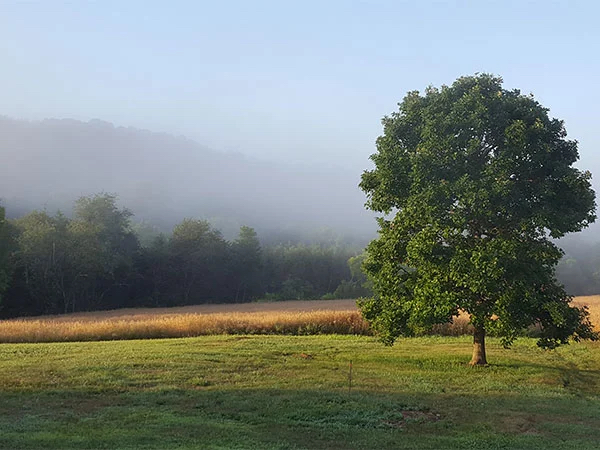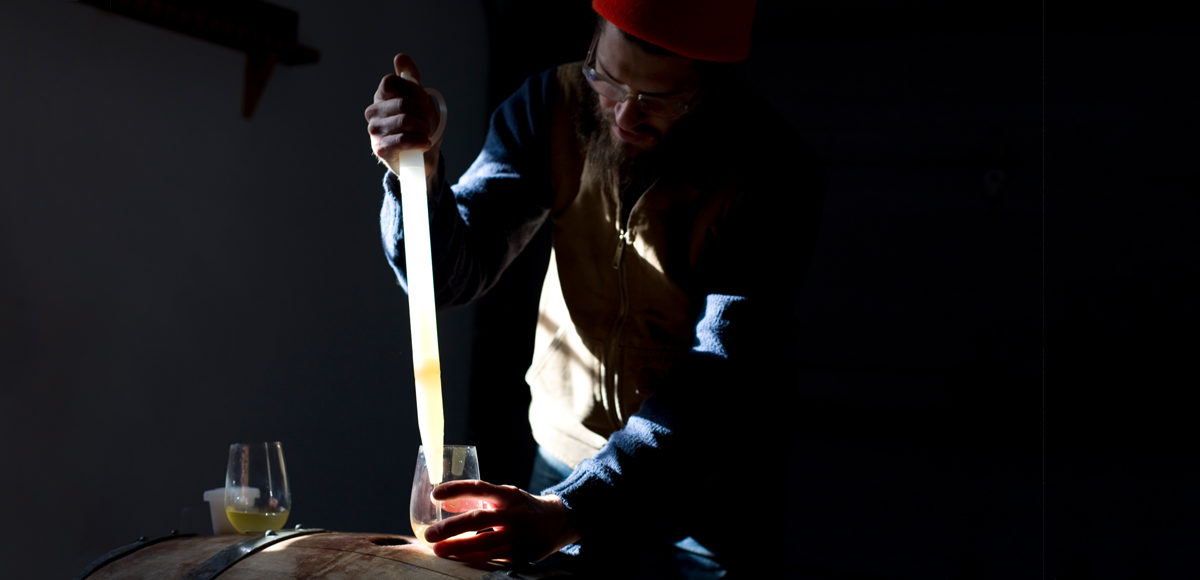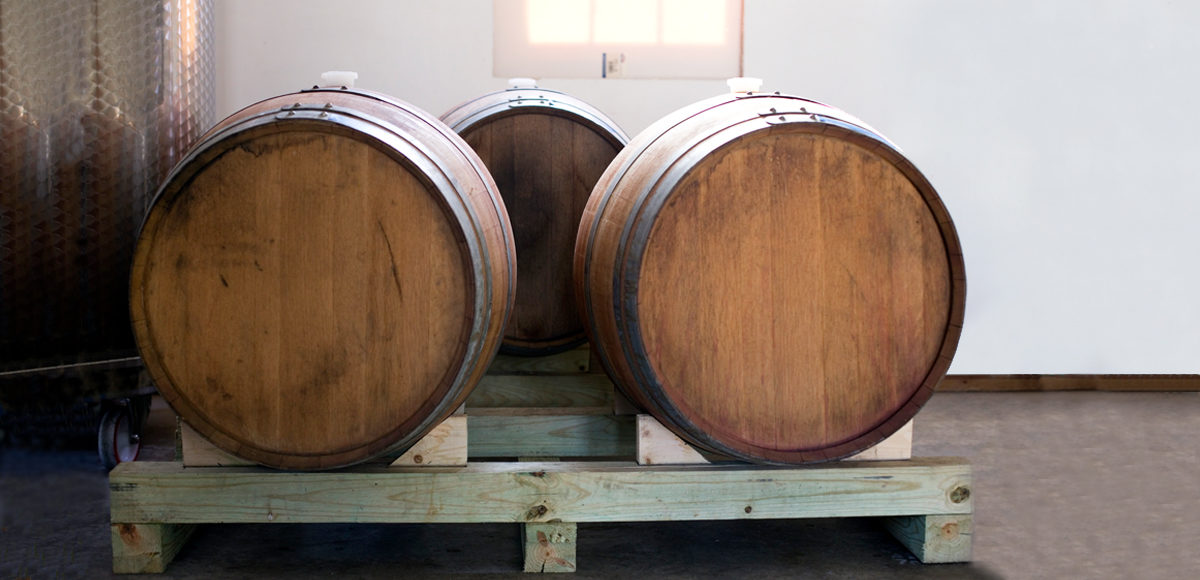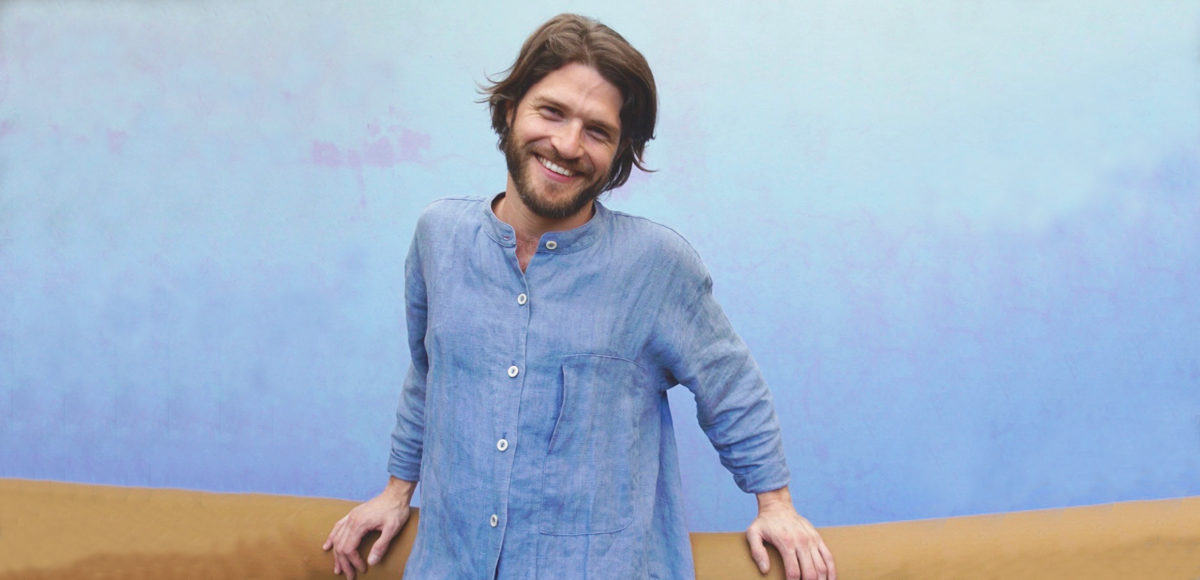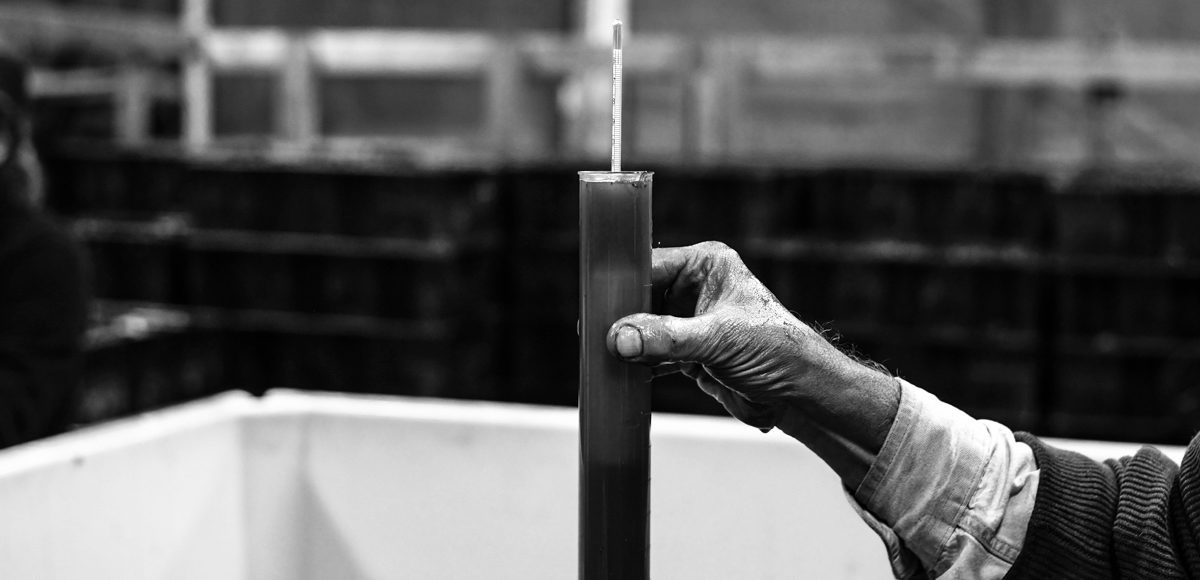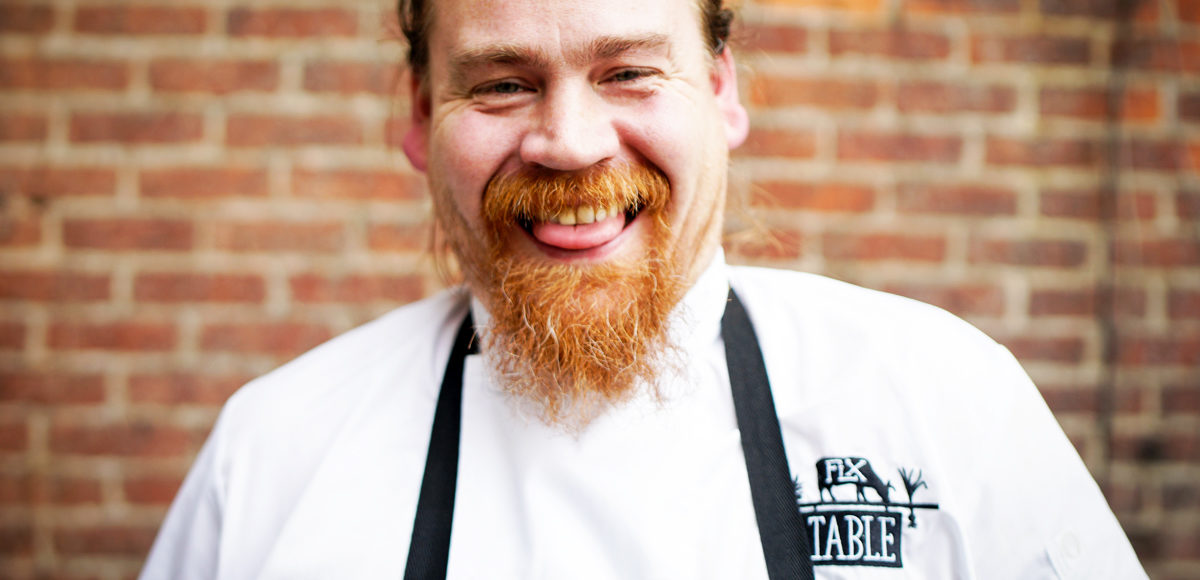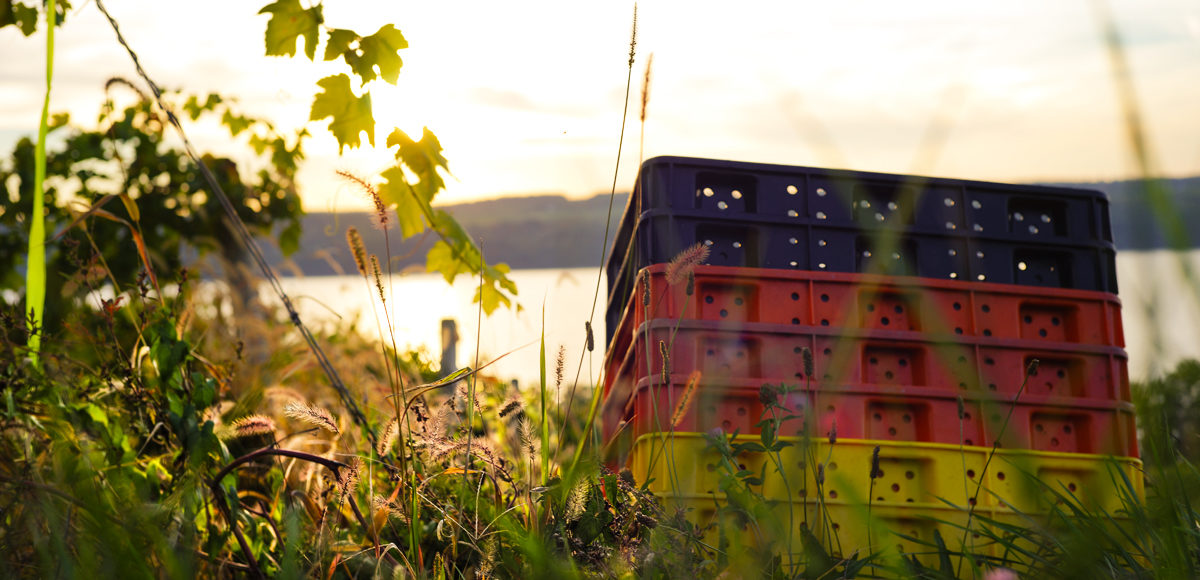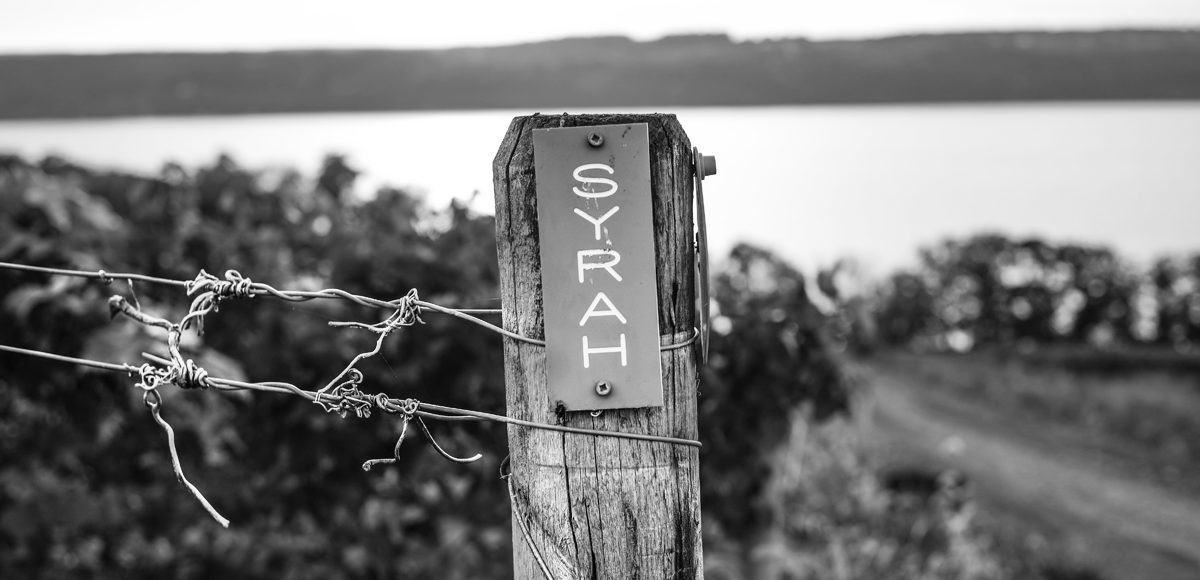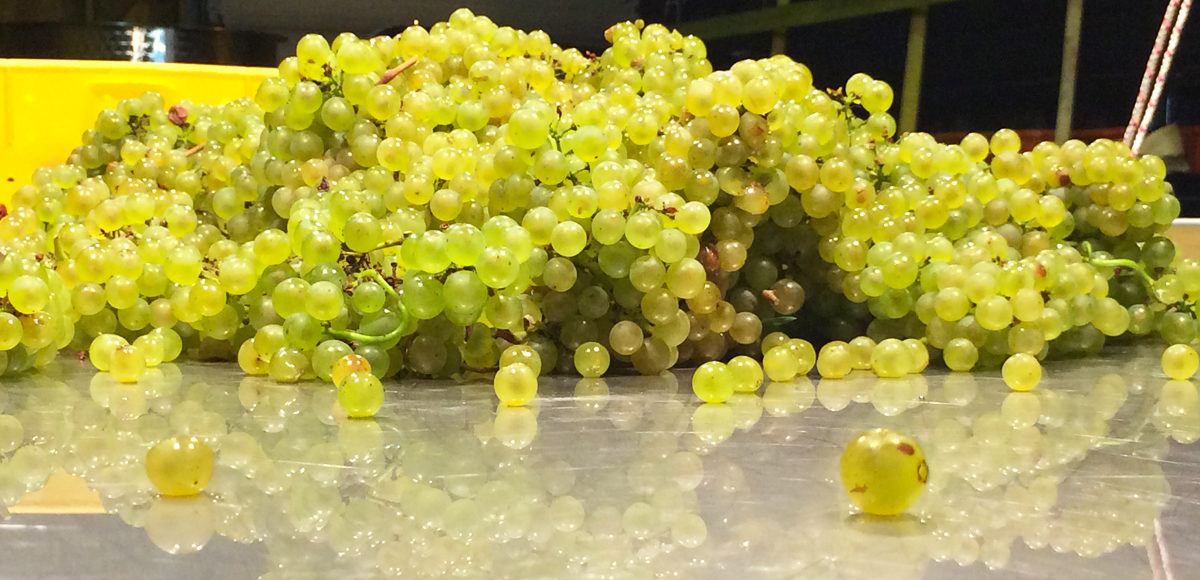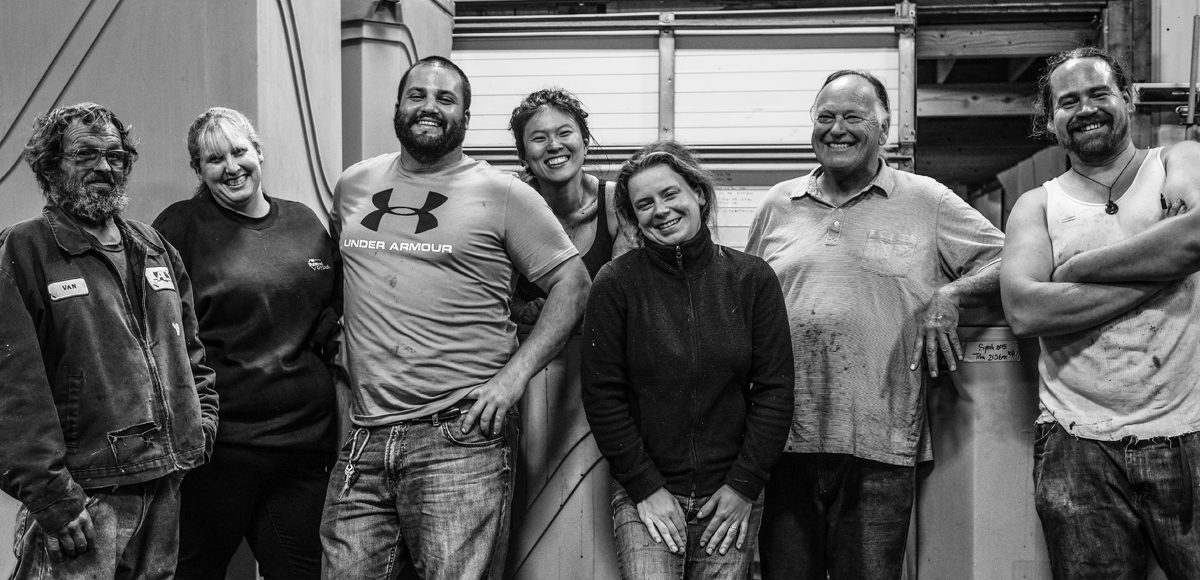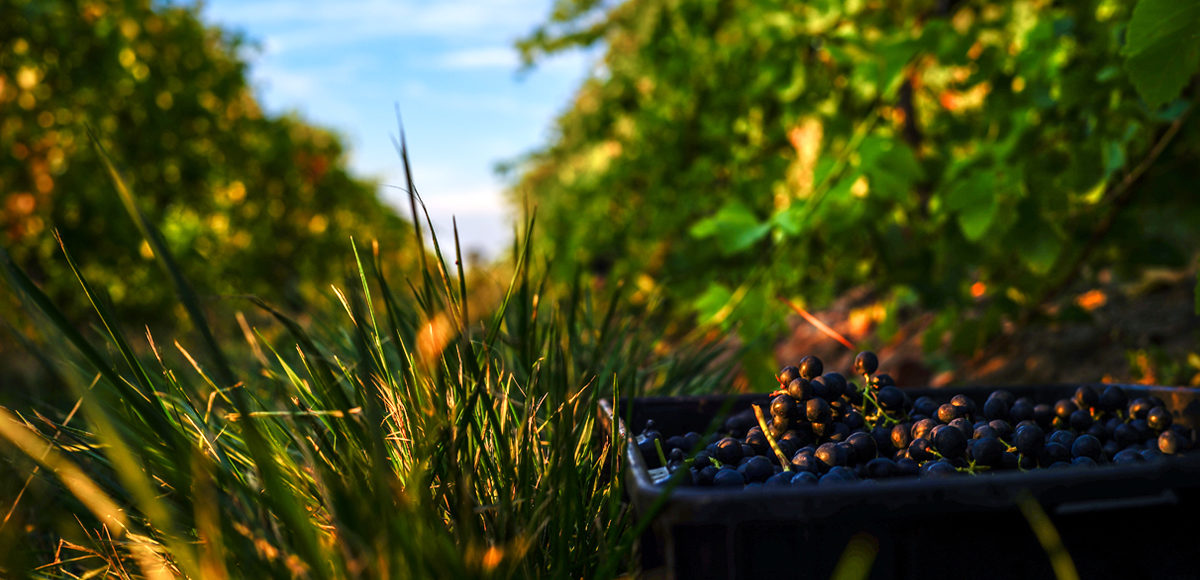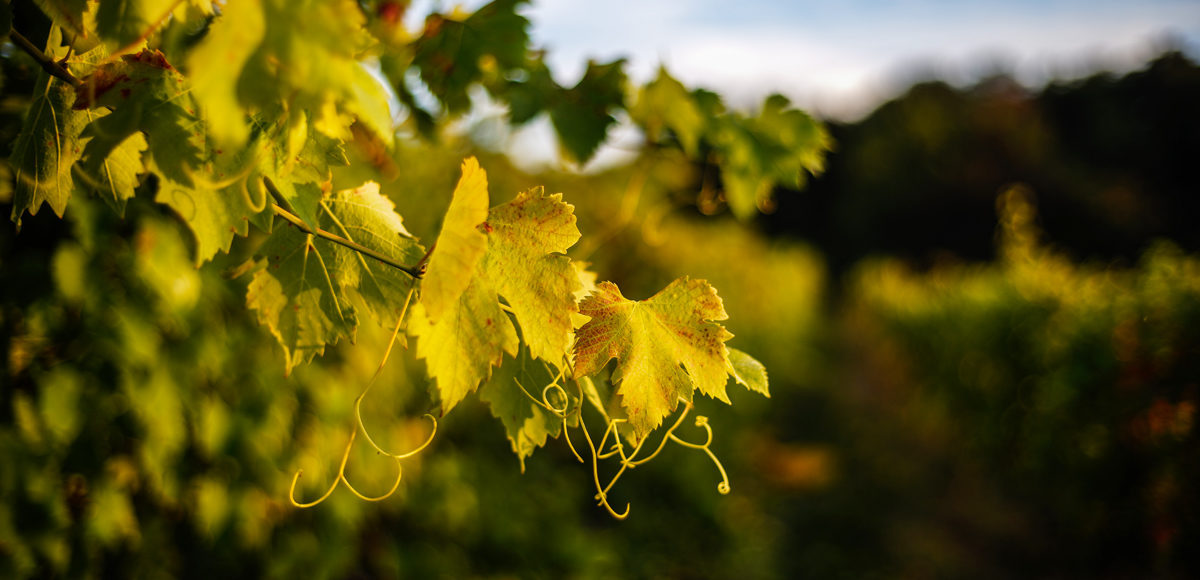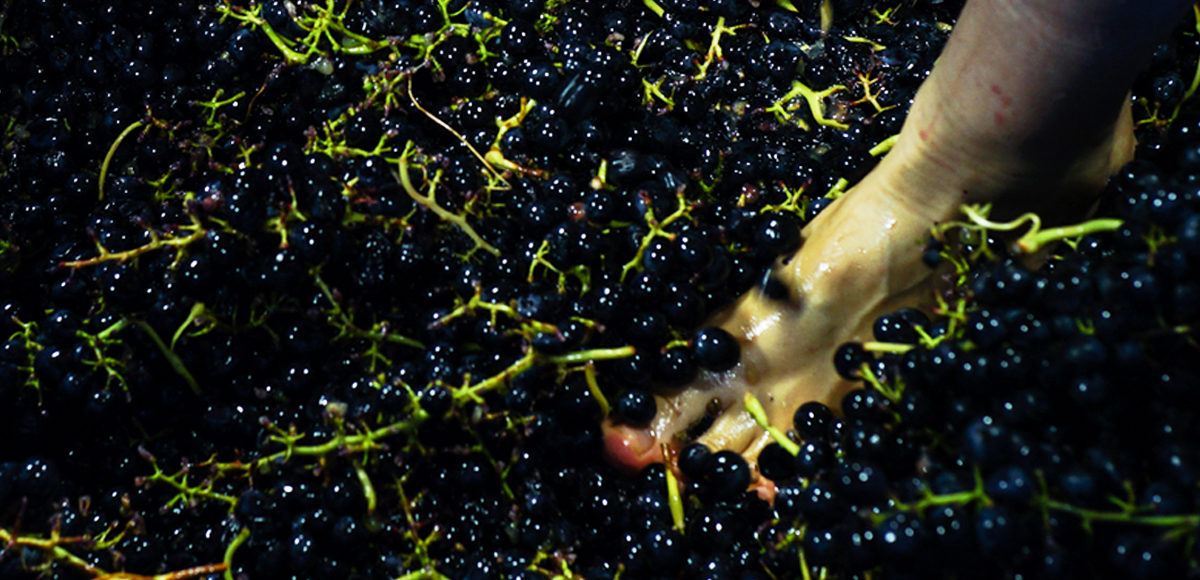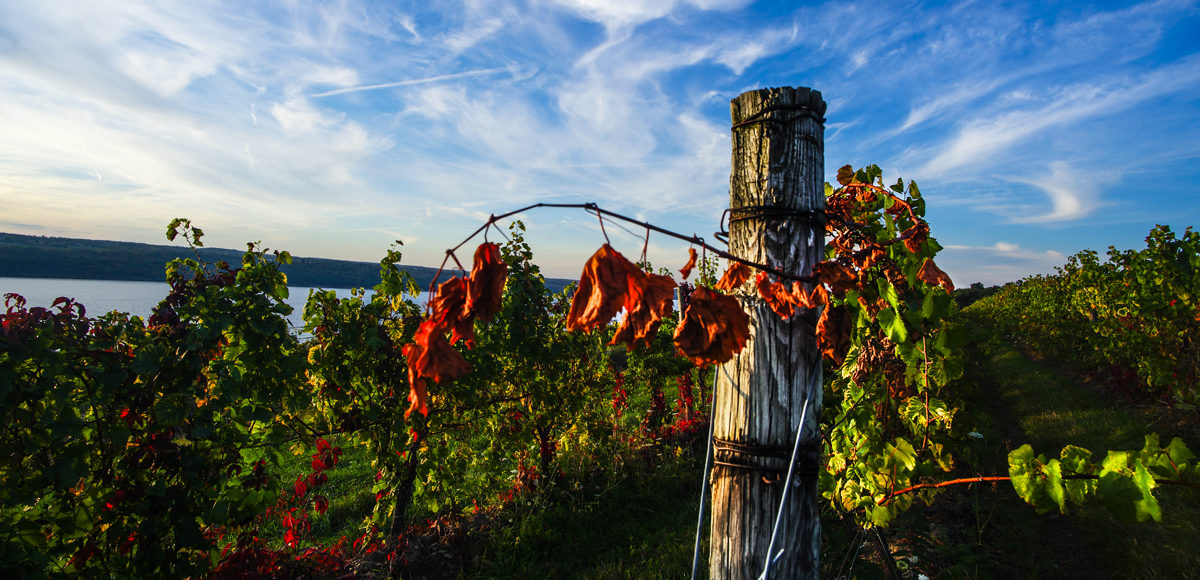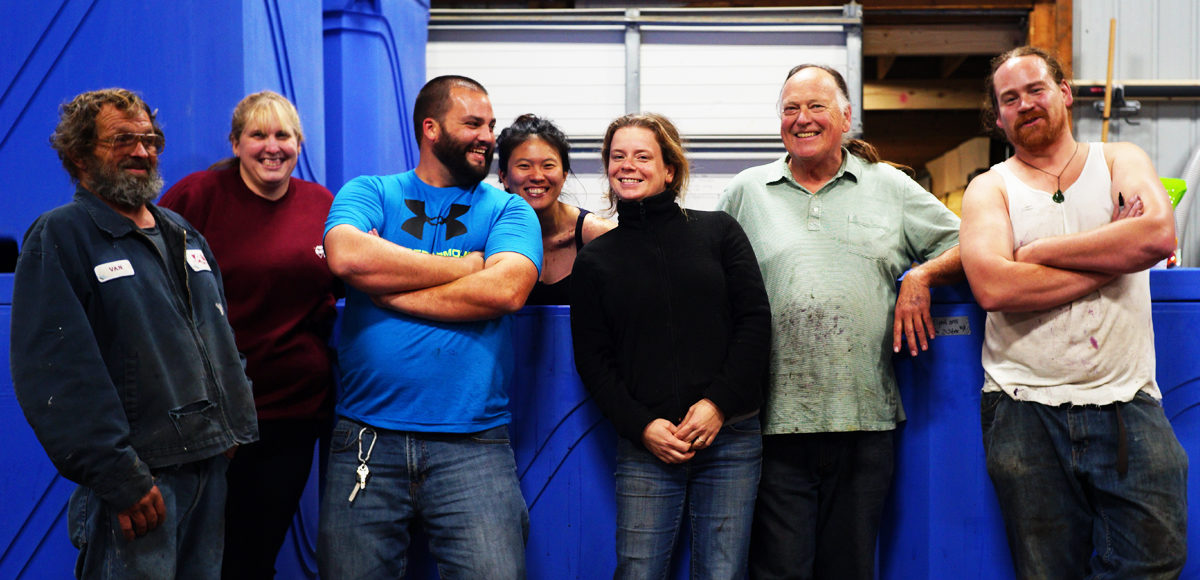“We sought to transform this abandoned mixed farm through integrated, organic, and regenerative practices. Our aim is to make spirits that are the purest, most complex liquid expressions of place.” — Robin Touchet and Kevin Pike
Look down at the Hudson Valley as a bird would. Orient yourself along the broad, north-south river line. Emerald forests and flaxen fields spread outward in succession. Drift lower. A gentle hollow, banked by soft hills, draws the eye. The fine vein of a creek, the glint of a barn roof come into view. Glide over at just the right late-summer moment and you’ll catch a glimpse of a rumpled white quilt — a field of buckwheat in full flower, growing waist-high and humming with life from root to bloom.
Welcome to Branchwater Farms.
Why “Farms,” plural? The answer is revealing. Ever since Robin Touchet and Kevin Pike found and purchased Branchwater, their vision was of an integrated ecosystem of micro-farms, a polyculture of grains, woods, and animals cultivated in accordance with organic and regenerative farming principles. In the process, they’re building bonds they hope will become exponential as more people learn about this work and the promise it offers for our planet’s future.
Past
It is difficult to know how this parcel of land was lived on and managed before European colonists arrived. It was most likely populated by native Mohican (or Mahikan) people. Their lives were rooted in the woodlands and the surrounding water systems. Some geographical landmarks, like the Little Wappinger Creek that runs through the farm today, carry the names of native forebearers.
Historical records indicate the farm was established in the late 1700s. Much of the land was deforested in the 1800s. But, as photographs show, a century later, small stands of fruit trees had taken hold. One image, from the 1940s, shows a form of polyculture in vibrant practice: an integrated, diverse system of small, dedicated parcels, separated by tree lines, waterways, and stone walls, supporting a mix of crops and animals. Robin and Kevin consider that period to be a golden era for this land, one they aim to recreate in accord with its natural inclinations. At Branchwater’s heart is a post-and-beam cow barn, built in the mid-1800s. With loving care and expert craftsmanship, they’ve brought it back to life as Branchwater’s distillery and tasting room.
The Growers
Nature determines most of the parameters of a farm. But its organizing principle comes from people: traditions and intentions, gifts and constraints. Robin Touchet and Kevin Pike purchased Branchwater Farms in 2014 and have made their home and life there since.
Robin grew up in northern Virginia, but her fondest memories are of exploring her father’s family farm in Louisiana. She always loved the wild (and was a little wild herself!). After graduating from the University of Virginia with a major in art history, her restless soul led her to Oregon and Italy, before settling in New York City. There she began a career in wine sales — and met her future husband.
Kevin grew up in Columbus, Ohio, but as a kid was happiest exploring his mother’s family farm in Iowa. After graduating from Swarthmore College with a degree in English literature and dreams of writing the great American novel, Kevin returned to Ohio and worked part time in wine retail to support his ambitions. Eventually Kevin moved to New York to oversee national sales and marketing for a large importer. After 13 years, he set out on his own, establishing Schatzi Wines. But he also had a long-held urge to grow and make something himself. When he and Robin found Branchwater Farms, that vision came more clearly into focus.
While they humbly acknowledge their role as the animating force that brought Branchwater Farms to new life, they also readily acknowledge how much of their dream has been made possible by their cherished extended family of friends, neighbors, colleagues, and mentors. Robin and Kevin like to think those spirits are distilled into theirs.
Fields and farming
While still very busy with their wine work lives, Robin and Kevin suddenly found themselves farmers. They planted red clover, started a compost program, cut hay. They ran soil tests and learned they needed to condition the earth with tons of lime from a nearby quarry. They planted winter wheat and rye. And they soaked up all the information they could find about things like open-pollinated heirloom corn varieties and beekeeping.
Inevitably, their inexperience led to some failures. Wild turkeys ate the corn, a crop was lost to drought. They read more, asked harder questions, and looked to the land itself for answers.
Three years in, they initiated a more comprehensive program of crop rotation, cover crops, and no till. Their goals shifted from high crop yields to retaining water, opening the soils, and building their health. With this approach, something completely different began to emerge: the fields developed robust biomass through which came clover, radish, and rye.
Soil tests at the end of 2018 further confirmed their new ideas were working. That summer, a carpet of white buckwheat flowers, a good source of pollen and nectar for their bees, gave visual assurance as well.
But they still felt they needed guidance from someone who knew how rocky the road to regenerative farming can feel. Enter Mimi Casteel. Mimi has an extraordinary ability to explain the most complex concepts in regenerative agriculture with clarity and compassion. In spring 2019, Mimi came to Branchwater to walk the land and help Robin and Kevin understand what the land was asking them to do. Since that visit, there have been days when they look out at the fields and think, Oh dear God, what a mess! But Mimi says that’s as it should be. They find genuine excitement in letting go and waiting to see what happens next.
Now, Branchwater pulls from a broad palette of holistic farming ideas: The biodynamic practice of brewing and applying compost teas. No-till, which comes from ancient customs. Masanobu Fukuoka’s “do-nothing” technique. Taken together, these form a philosophy of farming that prioritizes repairing nature’s processes instead of interrupting them.
Why does all this matter for Branchwater’s spirits? Robin and Kevin believe regenerative farming will have a tangible impact on the vitality of their grains. By laying the groundwork for the symbiotic network between plant root and soil fungi called mycorrhizae, their plants will be able to take up nutrients they need and put back into the soil those they do not (other plants will happily use them!). This should mean more carbohydrates stored in the grains themselves, which should provide more sugar to unlock in fermentation.
Might their choice to work with heritage grains also produce more complex flavors once fermented? They think the answer is yes. Kevin’s research into heritage wheat shows a definite correlation between heritage varieties and bread flavor and complexity. Why wouldn’t the same be true of spirits?
They wanted to work with heirloom grain varieties — wheat, rye, and corn for gin, bourbon, and rye — because of how they farm. For instance, they selected an old variety of wheat called warthog because it produces a very long straw that puts the grain head almost two-and-a-half feet above the ground. They need that because there’s no way they could get modern varieties (which are shorter) ripe enough before competing plants take over.
Their current focus is on Danko Rye, a high-growing hybrid known for its spicy qualities, for whiskey; Bloody Butcher, used by distillers in the 19th century, for bourbon; and experiments with Red Fife, Warthog, and Rouge de Bordeaux wheat, for gin.
But a central tenet of regenerative farming is always have something growing in the fields. Robin and Kevin have co-planted oats, winter peas, clover, buckwheat, and daikon radish to increase biodiversity, add nitrogen, biomass, and water-retentive capabilities, and to prevent erosion and water run-off.
Beyond their own grains, Robin and Kevin look to the abundance of the Hudson Valley for responsibly farmed produce they cannot yet grow themselves.
Finally, one ingredient that is too often overlooked: Water. Water makes up as much as 50 percent of spirits. But most producers just turn on the tap and hope for the best. Robin and Kevin draw on their own, carefully analyzed well water for their spirits because they see it as another important expression of place.
Distilling
With everything they’re doing to grow the highest quality grains, Robin and Kevin can’t imagine taking the risk of degrading those ingredients with imperfect processing. Quality starts in the fields with farming, but it’s preserved in fermentation and refined by distillation.
The system at Branchwater is the culmination of a life’s work of trial-and-error design experience and peerless expertise in distillery systems designed by the legendary Austrian master distiller, Hans Reisetbauer.
Hans is obsessed with rendering the fruits of the landscape as the highest quality spirits. He started designing stills in 1994 and is entirely self taught. His uncompromising standards and willingness to try everything in pursuit of perfection have earned him respect around the world. Hans has invested decades in refining the calculations of time and temperature for each ingredient and vintage condition, every stage of fermentation and distillation. When Kevin told Hans he wanted to try the same thing here, Hans not only gave his full support but also had the extraordinary patience to wait for seven years to get it all going. Branchwater Farms is the only spirits producer in the U.S. he has chosen to work with.
Here’s how it works: After harvest, Kevin and Robin store the grain they grow as whole grains in bins behind the barn. Underneath each grain bin is a flex auger system that connects the bins to the grist house and the mill. Another flex auger connects the mill to the grist case inside the barn. The point of this system is to have a seamless transport of the whole grain from storage to the mill and into the mash tun for processing.
Timing is critical to the quality of Branchwater Farms’ spirits. Fermentation and distillation are performed in tandem because once the fermentation is complete, it must be distilled immediately. The cooling water from the distillery can be collected while it is running in the hot water tank. This tank can then be heated with steam to the temperatures needed to convert starch into fermentable sugars.
Robin and Kevin’s experience with wine informs the way they handle the grain. They mill it just before fermentation to prevent oxidation of the grist and to preserve fruitiness in the resulting fermentation. When the ferment is distilled, the result is a sense of sweetness on the palate.
Distilling is concentrating the essence of what was fermented by separating ethanol from water, solids, and other chemical compounds in the fermented mixture. It is about time and temperature. It is also about the tools and the process. Most importantly, it is about aroma and taste.
Sundström Cider
Leif Sundström lives and works in New York’s Hudson Valley, helping to revive the region’s centuries-old tradition of preserving orchard fruit as cider, a drink that evokes early America’s agrarian past and, Leif believes, points the way to the region’s farming future. Leif is animated by the search for “the impacts of terroir and agriculture on cider’s ultimate potential” — and his conviction that cider from the northeastern U.S. is “poised to be among the best in the world.”
Leif makes tiny quantities of still and sparkling ciders. The fruit he uses is a blend of heirloom apples selected to express the delicate differences in variety and terroir of three historic cider-producing regions in New York. Fermentations start with a wild yeast pied du cuvée, and run long and cool to complete dryness. There is oak aging and considerable lees exposure. The sparkling ciders are traditional method without disgorgement.
The results are vinous ciders of tremendous character — textured, delicate, and nuanced, revealing of tradition, region, variety, method, and intent. Their notably high acids and greater phenolic content from maceration processes and lees contact, as well as bottling with their lees, equip them for aging and evolution in bottle.
Leif Sundström
Leif’s path to cider traces back to Ur-Schatzis Kevin Pike and Johannes Leitz. In 2002, Leif left his native Texas for Portland, Oregon and, while pursuing a passion for music there, found his place in the wine industry, including a formative period at Portland’s Boedecker Cellars. From Portland, Leif moved to New York City, to work under Kevin managing the Terry Theise portfolio of German, Austrian, and Champagne grower-producers. “I learned a vast amount about the winemaking process through direct conversations with all the growers in that portfolio,” Leif notes.
In 2013, he left New York for the Rheingau, Germany to work under Johannes. “There I began to taste simple but honest German ciders that made me aware there was incredible potential in these fruits. Working at Leitz after having worked at the winery in Oregon, I was reminded how important this type of work is to me and that this is what I truly wanted to be doing.” When Leif returned to New York, he began to explore ways to realize this vision there. Cider making was a perfect fit. He dove into an intensive study of apple growing, built community with other growers, launched a search for planted cider apple varieties and, in time, began to help plant organic cider apple orchards.
Today, Leif operates one of the country’s most forward-thinking cideries. Although he works alone, he sees himself as part of the broader northeastern U.S. cider-making collective. He aligns himself with the work of horticulturist Mike Biltonen. Biointensive orchard management — with its focus on building soil health as a key to tree and fruit vitality — is a hallmark of Biltonen’s approach and important to Leif’s thinking about the orchards and growers he works with.
Leif takes inspiration from cider makers around the northeastern U.S. who’ve “been dedicating their lives to cider for a long time.” Among them are the Finger Lakes’ Eric Shatt of Redbyrd Cider and Autumn Stoschek of Eve’s Cider, as well as Eleanor Leger of Eden Cider in Vermont. More broadly, the ciders of Bordelet, Reisetbauer, Ciderie du Vulcain, and Tom Oliver are important influences.
History
You might say cider flourished in early America precisely because wine failed. When English colonists came to America in the 17th century, some harbored hopes of having vineyards here. But vinifera vines succumbed to disease, while apple orchards thrived. Both wild and cultivated apple trees are excellently suited to the fertile soils and cool climates of the northeastern U.S. They are abundant providers and cider has long been a pragmatic method of capturing and preserving that abundance.
However, the arrival of German immigrants and their beer culture in the mid-18th century pushed cider aside. Prohibition dealt cider another blow. Then, as Leif tells it, “the New York State apple industry’s reliance on New York City as a market has meant easily farmed, shelf-ready crops have, over time, eclipsed fruit that would allow for quality cider production.” But now the scales are tipping back. A community of grower-producers are tending the historic native variety fruit trees that survive, cultivating new orchards of cider apple trees, and paying “closer attention to how they grow their fruit in accordance not only with Mother Earth, but final quality output as well.”
Orchards
“I produce cider in the Hudson Valley, but I acquire apples from a few different regions,” Leif explains. His fruit sources are in Columbia County (Hudson Valley), the Finger Lakes (between Cayuga and Seneca lakes), and Wayne County (north of the Finger Lakes — “in what some cider makers refer to as Greater Lake Ontario,” Leif adds). He plans to add Catskill Mountain area fruit soon.
The Hudson Valley is Leif’s home and focus. “It’s is a very large and diverse area, which should likely be divided when understanding apples in the context of terroir is more understood,” explains Leif. “The Hudson Valley’s terroirs provide so much potential for extremely high-quality ciders. Yet it is really only right now that producers and growers with a concern for this are beginning to access that potential. What makes this region most unique is that it is in a very encouraging moment of self-discovery and potential realization.”
Soils of the Hudson Valley are varied, but Columbia County, where Leif sources fruit, is all sandy loam. This, combined with a relatively warm microclimate, contributes dense orange oil-like and pit fruit flavors and a fuller body to the ciders. He points out that “phenolic content is significant here as well, and for many varieties the pH/acid-to-ripeness balance is supreme. Vinous-style ciders that are still very balanced are very possible here.”
“The Finger Lakes offers a contrast, with a more moderated climate, and later flowering and harvest,” notes Leif. “The same apples grown in the Finger Lakes may not have as much ripeness as the Hudson Valley in some years, but they always have a more distinctive acidity due to the overall cooler climate.” The Finger Lakes soils are largely glacial, yielding apples that give what Leif calls “a wonderful depth of flavor, very focused and high-toned, reminiscent of citrus and tropical fruits.”
“Greater Lake Ontario is a region that performs somewhere in between the other two regions in terms of ripeness and acidity. Profiles here are gentler, providing charm and balance,” Leif feels. The harsh climate is moderated by the vast lake, but of the regions Leif works, it is the last to bloom. These factors, combined with predominantly loam soils, produce rounder, softer, gentler flavors.
“My ultimate goal with Sundström Cider is to be able to source from multiple regions, and ideally be able to work with enough developing orchards that I can produce single-orchard ciders from each of those regions in an effort to document some element of terroir throughout the years, so that I have something to look back on, to become better informed about them. Sponti will likely always be a blend of the regions, while the other future bottlings aim to be very terroir specific,” explains Leif.
Fruit
Leif’s interest is in heirloom varieties, many native to the northeastern United States, and traditional cider varieties, including Golden Russet, Ashmead’s Kernel, Northern Spy, Newtown Pippin, Roxbury Russet, Wickson, Baldwin, and Rhode Island Greening. Leif also looks to apples of French or British origin that are grown specifically for cider in those countries. Leif believes the key point is that “most cider consumers are not even aware of which apple varieties they are drinking. Grape variety is almost always of decisive importance to a consumer when buying a wine, and hops variety is becoming increasingly important to consumers of craft beer. Why aren’t people asking which varieties of apples are in their ciders?”
Farming
Leif encourages more wholistic farming methods, including Integrated Pest Management, among the growers he works with. Looking ahead, Leif says, “I have helped plant several new orchards, all of which are entirely cider-focused, with variety selection, planting, and farming methods aimed at producing the best quality cider. These are in several different regions of our state and [should] begin bearing significant quantities of fruit in the next two to five years.”
“Apples are at a greater disadvantage than most fruit,” Leif explains. “They have a longer growing season and are therefore subject to more possible diseases, pests, and natural climatic pressures. The great irony is that eating apples often gather the cheapest price per pound at market, though they require the most inputs and attention in the orchard. These natural facts, coupled with the public’s expectation that the fruit be ‘perfect,’ have created a culture that has put organic orcharding in a very difficult transition — largely because there are very few incentives to convert. Organic is more than just a catch phrase, it is a true crusade.”
Cellar
The cellar work at Sundström Cider is rooted in traditional techniques and minimal intervention. Ripeness, acids, tannins, and pH determine cider style. Complexity, texture, and depth come from the cider maker’s choice of apple varieties, fermentation style, and time on the lees.
The ciders start with the “sweating” of select varieties. A portion of the fruit’s water content is allowed to evaporate at cool cellar temperature over a period of several weeks, concentrating sugars, phenolics, and acids, and also allowing the fruit to develop more complex flavors. The same varieties that are selected for sweating are then ground and macerated for up to 48 hours, depending on variety and vintage. Maceration draws more phenolics, aromatics, and flavors into the juice, and helps to stabilize it with the natural antioxidants found in the apple pomace. This also allows for positive oxidation to contribute to fixing phenolics and tannin.
Post-maceration, the must is pressed direct to tank for fermentation. All inoculations are from native yeast cultured in a pied du cuvée. (Leif’s began with a spontaneous fermentation of wild crabapples, and has been “cycled from vintage to vintage to maintain an ever-growing and evolving native yeast for three years now,” he says.) Fermentations occur without temperature control, primarily in the cool months of November and December. Ciders destined for oak aging are racked to barrel just before sugars reach zero, to allow the final phases of fermentation to occur in oak and to carry more suspended lees into the aging process. All tank-aged ciders remain on their gross lees until bottling. Aging of the ciders occurs for an average of six months before bottling.
The barrel-aged ciders are raised in neutral wine barrique. Battonage is practiced, with varying degrees of frequency, dependent on each vintage’s specific ripeness and phenolic concentration. Sulfur is used sparingly and judiciously. Depending on a cider’s pH, it may be sulfured once after alcoholic fermentation, but generally this does not occur until the ciders are racked to bottling tank and then at a minimal rate in accordance with their specific pHs.
All sparkling ciders are refermented in bottle without disgorgement. Fine lees are left in the bottle to allow the ciders to continue their evolution. “I am not as interested in clarity of the cider or a controlled consistency of the cider from bottle to bottle as much as I am interested in these ciders being the best they can be each time a bottle is opened,” explains Leif. “I do, however, recommend that consumers allow bottles to settle upright and to pour carefully to avoid as much sediment as possible.” That said, “the lees are always very fine and even when they make it into the glass, they are themselves quite pleasurable.” Cider/Cider may even be better when cloudier. Leif recommends it as “a cider to be drunk more casually and younger — so be free with it.”
Christopher Bates met his wife, Isabel Bogadtke, while working at Immich Batterieberg in the Mosel back in 2004. They were both there to learn how to make wine in a place they both loved, though it turns out they had much more in common than a passion for winemaking.
Christopher Bates, MS, has spent over 15 years in all aspects of the hospitality industry. At the ripe age of fourteen Christopher embarked upon his restaurant journey—first as a dishwasher, then as a busboy, a server and eventually as a cook. After choosing to attend the Cornell School of Hotel Administration, it became obvious that this passion was to become his career path. As a freshman, Christopher spent most his time as a cook at the Statler Hotel where he had the opportunity to learn from several influential mentors. It was also at that time that he became interested in wine. Already a fan and student of single malt scotch, he was encouraged to learn more about wine when his father Robert (co-owner of Element Winery) gave him an issue of Wine Spectator to read. With the influences from professors and peers at the Hotel School, Christopher became obsessed with not only wine, but beverages in general. Food, drink, and the hospitality therein, sculpted Chris’ future.
Isabel also started her career in hospitality, though she was mostly focused on service. Growing up in Berlin, she worked for a Relais & Chateaux property in Germany before moving to Frankfurt where she worked at the Michelin starred Brick restaurant. After harvest in the Mosel, Isabel and Christopher moved to Italy where she worked at a winery during the day and at Christopher’s restaurant at night. Along with Christopher, she has spent the last seven years managing first The Inn at Dos Brisas, and later the Hotel Fauchere. While at the Inn at Dos Brisas, Isabel was awarded Best Service in the World by Mobil Travel Guide, and remains the only person to have ever received this honor.
Upon returning to the states, the couple began to think about how they could take advantage of cool climate fruit that grows in upstate New York, and so they began with apples. Having grown up in the area with parents who loved to ferment cider and beer, Chris was well-aware of the region’s potential for quality beverages. In 2006, Chris and Isabel processed their first few tons of apples and pressed beautiful cider—they fermented it spontaneously in a makeshift winery at his parent’s house. After several years of production and administrative challenges, they were near ready to give up when Robert Bates, Chris’ father, filled an empty tank with Riesling in 2009 as an experiment. As the grapes slowly began to ferment, it became apparent that they were onto something special. Wanting to dig deeper, they traveled and tasted constantly before ultimately deciding to take the plunge and capitalize on the region’s (then untapped) potential. Now, after seven years of experimenting with winemaking and exploring their local terroir, Chris and Isabel have purchased their first estate vineyards.
Though the history of wine growing in the region dates back to the mid 1800s, it was not until the 1960’s that grapes became a serious topic of conversation; an active tourism industry helped put these wines on the map. In the last decade, however, the wines of the Finger Lakes have picked up momentum and have reached wider audiences, which has resulted in a steady improvement in overall quality.
The Finger Lakes region is in upstate New York, roughly between Rochester and Syracuse, and is the state’s largest wine growing region with more than one hundred wineries and countless vineyards planted around Cayuga, Seneca, Canandaigua, Keuka, Conesus, and Hemlock Lakes. Without the lakes’ influence, growing vinifera in this part of the world would be nearly impossible, as the weather conditions are too extreme; not only is there a severe diurnal shift, the summers are very cold, and inversely, the winters are quite mild. These deep, glacial lakes create a lake-effect which help moderate temperatures and deter spring frosts (during shoot development) and fall frosts, leading up to harvest. Melting glaciers dispersed the soils, consisting of gravel, limestone, clay, and silt, over extremely deep shale subsoils that help drain the region’s plentiful rain fall. Cool evening temperatures and long hang times help the grapes develop beautiful flavors without the added risk of over ripeness. As a result, the wines are often delicate, balanced, and elegant.
Element’s intention is to make sound wine with as little intervention as possible. They will forever be committed to quality over quantity and strive to produce clean fruit with proper flavor development. They have discontinued the use of herbicides in the vineyards and are working hard to naturally restore the biodiversity in the soils. Grapes are picked by hand and are hand-sorted. Wines are fermented slowly and spontaneously without temperature control and whites often go through malo. The grapes are basket-pressed, undergo a short settling and are racked into old, neutral puncheons where they will rest without disturbance until bottling. There are no additions and no adjustments, the wines are unfiltered and unfined.
When asked about is his philosophy, Chris replied:
Be the best. Work hard, relentlessly, despite opposition and doubt, with the understanding that we are creating the future of this wine region and believe that one day it will stand amongst the great wine regions of the world.
Today, Christopher and Isabel own F.L.X. Winery and Element Winery, F.L.X. Table (a small restaurant focused on a communal tasting menu) and F.L.X. Culture House (a nano-brewery focused on sours and barrel aged beers) in the Finger Lakes.
